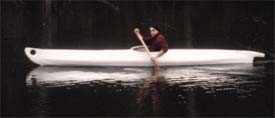I built this Nunivak qayar for Cup'ig Eskimo Abe David and family
.
It will be shipped to the village of Mekoryuk this month.
Length is 15 foot 9 inches long, beam 28 inches wide. The design is based
in part on a frame built in the 70's by Abe's Father -in-law, Edward Kiokan
who was probably the last elder with full knowledge of the building process.
I also used some ideas from several other frames which I examined in the course
of field research in the Y-K delta.

Click for enlarged image / more pictures.
This kayak can be used with a single and double-bladed paddle. The kayak tracks well with sweeping strokes required for tight maneuvering. Two or three strokes per side with the single paddle produces a slight yaw that tends to cancel itself out. Ignoring it is more efficent than using some sort of rudder or "J" stroke.
This kayak is Nunivak style which means there are only five heavier ribs amidships(not 11) and only four stringers per side (not five) plus the keel. The 28 inch beam is actually narrow by modern standards, most examples are closer to 30 inches or wider. Bering sea qayaqs gained beam after the introduction of firearms but the exact reason for this is not known.
This is a high volume kayak but the boat doesn't feel cumbersome. It is much too soon to draw conclusions other than to report it is fun to paddle and comfortable to relax in. The kayak is a little more lively than similar hulls with flatter, wider bottom sections, but that it is to be expected. There is nothing tricky or nervous about it, although climbing into such a deep hull takes a little getting used to. Once in the roomy cockpit the paddler feels very sheltered and secure.
The bow and stern pieces are golden locust, as are the main deckbeams. Other framing is primarily yellow cedar, red cedar and Fir. Longitudinals are yellow cedar. Bering sea kayaks tended to be heavier built, and since this one will ride on a sled behind a snow machine, we substituted oak instead of the traditional spruce for ribs.
The kayak is skinned with 9 oz. polyester coated with tinted urethane rubber. It appears to be a very durable system. White is a prefered color for this type of kayak which is intended to be operating out in the ice.